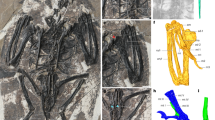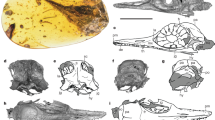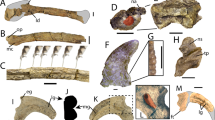Abstract
Since the description of Confuciusornis (the oldest beaked bird) in1995, based on three partial specimens, large numbers of complete skeletons have been recovered1,2. Most new material of Confuciusornis3,4 can be assigned to a single sexually dimorphic species, C. sanctus . Here we report a new species based on a remarkably well preserved skeleton with feathers and, for the first time in the Mesozoic record, direct evidence of the shape of a horny beak. It has a complete and large preserved postorbital that has a broad contact with the jugal bone. This character is presently only known in Confuciusornis, and may confirm previous suggestions of a postorbital in Archaeopteryx5. The squamosal is in tight contact with the postorbital. These two bones form an arch dividing the upper and lower temporal fenestrae, as in other diapsid reptiles6. The presence of a typical diapsid cheek region with two openings in Confuciusornis may preclude the presence of prokinesis (upper jaw mobility against the braincase and orbital area), a feeding adaptation found in most modern birds. The presence of a horny beak, characteristic of modern birds, coupled with a primitive temporal region provides new evidence for a mosaic pattern in the early evolution of birds.
This is a preview of subscription content, access via your institution
Access options
Subscribe to this journal
Receive 51 print issues and online access
$199.00 per year
only $3.90 per issue
Buy this article
- Purchase on Springer Link
- Instant access to full article PDF
Prices may be subject to local taxes which are calculated during checkout


Similar content being viewed by others
References
Hou, L., Martin, L. D., Zhou, Z. & Feduccia, A. Early adaptive radiation of birds: evidence from fossils from northeastern China. Science 274, 1164–1167 (1996).
Peters, D. S. Ein nahezu vollständiges Skellette eines urtümlichen Vogels aus China. Natur und Museum 126, 298–302 (1996).
Hou, L., Zhou, Z., Gu, Y. & Zhang, H. Confuciusornis sanctus, a new Late Jurassic sauriurine bird from China. Chin. Sci. Bull. 40, 1545–1551 (1995).
Hou, L., Zhou, Z., Martin, L. D. & Feduccia, A. Abeaked bird from the Jurassic of China. Nature 377, 616–618 (1995).
Elzanowski, A. & Wellnhofer, P. Cranial morphology of Archaeopteryx : evidence from the seventh skeleton. J. Vert. Paleontol. 16, 81–94 (1996).
Reisz, R. R. Adiapsid reptile from the Pennsylvanian of Kansas. Special Publ. Nat. Hist. Mus. Univ. Kansas 7, 1–74 (1981).
Colbert, E. H. & Russell, D. A. The small Cretaceous dinosaur Dromaeosaurus . Amer. Mus. Novit. 2380, 1–49 (1969).
Wellnhofer, P. Das fünfte Skelettexemplar von Archaeopteryx . Palaeontographica A 147, 169–216 (1974).
Zhou, Z., Jin, F. & Zhang, J. Preliminary report on a Mesozoic bird from Liaoning, China. Chin. Sci. Bull. 37, 1365–1368 (1992).
Zhou, Z. The discovery of Early Cretaceous birds in China. Cour. Forchungsinst. Senckenb. 181, 9–22 (1995).
Martin, L. D. & Zhou, Z. Archaeopteryx -like skull in enantiornithine bird. Nature 389, 556 (1997).
Sanz, J. L. et al. . An Early Cretaceous bird from Spain and its implication for the evolution of avian flight. Science 276, 1543–1546 (1997).
Zhou, Z. & Hou, L. Confuciusornis and the early evolution of birds. Vertebr. PalAsiat 36, 136–146 (1998).
Hou, L., Martin, L. D., Zhou, Z. & Feduccia, A. Archaeopteryx to opposite birds—missing link from the Mesozoic of China. Vertebr. PalAsiat. 37(in the press).
Feduccia, A. The Origin and Evolution of Birds(Yale Univ. Press, New Haven, 1996).
Chatterjee, S. The Rise of Birds(John Hopkins University Press, Baltimore, 1997).
Martin, L. D. & Miao, D. in Short Papers of the Sixth Symposium on Mesozoic Terrestrial Ecosystems and Biota 217–219 (China Ocean Press, Beijing, 1995).
Acknowledgements
We thank L. Witmer and S. Chatterjee for critical and helpful comments and reviews, and D. Miao for assistance and suggestions. The Chinese Natural Science Foundation, the National Geographic Society (U.S.) and the Grand Project of the Chinese Academy of Sciences supported fieldwork in Liaoning Province, northeast China. M. Tanner did the drawings and J. Chorn the photographs. D. Miao and J. Chorn critically read the manuscript.
Author information
Authors and Affiliations
Corresponding author
Rights and permissions
About this article
Cite this article
Hou, L., Martin, L., Zhou, Z. et al. A diapsid skull in a new species of the primitive bird Confuciusornis. Nature 399, 679–682 (1999). https://doi.org/10.1038/21411
Received:
Accepted:
Issue Date:
DOI: https://doi.org/10.1038/21411
This article is cited by
-
A new confuciusornithid bird with a secondary epiphyseal ossification reveals phylogenetic changes in confuciusornithid flight mode
Communications Biology (2022)
-
Exceptional preservation and foot structure reveal ecological transitions and lifestyles of early theropod flyers
Nature Communications (2022)
-
Disassociated rhamphotheca of fossil bird Confuciusornis informs early beak reconstruction, stress regime, and developmental patterns
Communications Biology (2020)
-
Study on the Jehol Biota: Recent advances and future prospects
Science China Earth Sciences (2020)
-
An unusual bird (Theropoda, Avialae) from the Early Cretaceous of Japan suggests complex evolutionary history of basal birds
Communications Biology (2019)
Comments
By submitting a comment you agree to abide by our Terms and Community Guidelines. If you find something abusive or that does not comply with our terms or guidelines please flag it as inappropriate.



